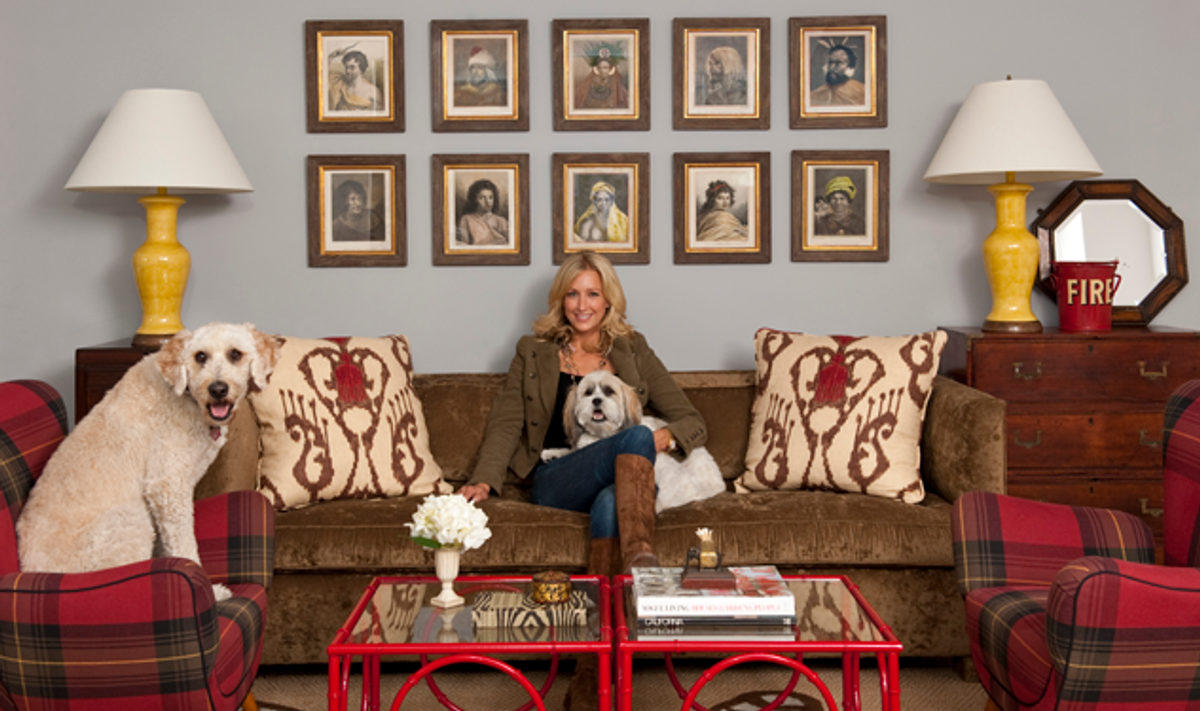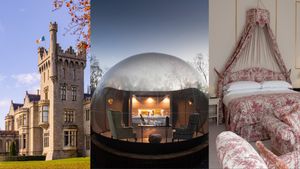Out: You're a long time thrifter and "sale-er," but what was your first memory where you discovered that this was a passion of yours, and it could something bigger than just a personal pleasure?
Lara Spencer: I remember being a very little girl, watching my mom pick out diamonds in the rough. In the setting of the yard sale they looked totally unremarkable and sometimes scary, but she would bring them home, re-cover them, polish them, and put them in a new context. It gave a completely new life to these pieces that other people saw as cast-offs. I definitely made a mental note of that, like, 'Wow, this is like treasure hunting." I remember thinking that.
Did she have--or did you, over time--develop a plan for shopping? It seems very on the fly, so how do you approach these ventures?
I always recommend to make a list, because it's easy to get overwhelmed--this is not a department store experience. Have a clear idea of what you're looking for, but also have an open mind. I usually look through magazines and pore over books. I have an idea of what I'm looking for, and I'm very flexible in interpreting it, in terms of what I find.
What, specifically, do you look for at thrift stores or flea markets? Since it can (a) be overwhelming and (b) people can overlook hidden gems.
If you judge the book by its cover, then you won't bring anything home, because most of the stuff is like a girl badly in need of a makeover. The number one thing that I look for is good bones, and by that I mean classic lines, quality construction, designers' marks--in terms of labels--some clue to see if it's a designer I like. I look for pieces that make me smile. I trust my gut--if I'm looking at a vintage oil painting, it doesn't matter to me whether that artist is well-known. It just matters whether I find beauty in that picture. And it doesn't matter if it's $5 or $500, if it makes you feel good, and you think it will brighten up your world and help create your personal space, then go for it. I liken it to Katharine Hepburn. She had great bone structure, so she could wear a pair of perfectly plain khakis and look phenomenal. I look for the plain Katherine Hepburns at yard sales.
Part of the reason I wanted to do this book was--we lived in a fancy town, but we didn't live in the fancy part--and my mother would hold her head high when we went to yard sales in the fancy part of town. She found pride in being "thrifty-chic," in being able to create a stylish room for next to nothing, it was her badge of honor.
I would tell beginners to look at interior design magazines and books, and pinpoint what about certain rooms attract them. I have books and books of tear-sheets, and I do the same thing for a client. For Kathy Griffin [who wrote the book's introduction], I asked her to give me a folder of pictures from 25 design magazines, and she ripped out all these pages, and circled the object that attracted her...And it was a bit like being a detective. I was to get a handle on what her style is and what appeals to her, and I went out and looked for pieces that were inspired by that style. So if you're attracted to a French country look, then if you're at a flea market look for one of those French Bergere chairs--believe me, they're everywhere. Don't worry about the paint finish, don't worry about the upholstery--try to see the lines of the piece. If you like a curvy leg, look for it. The paint, the fabric--that can be changed. The structure and quality of the workmanship can't.
What is a common mistake for both beginners and more seasoned thrifters?
Don't get lured by the bargain! I'm careful to not buy something just because it's a great deal. A home can quickly go from looking well-edited to looking like a hoarder's home. You want to be able to create rooms that look like they've been created over time, and are layered--that you didn't just order it out of the catalogue--but also not like just a bunch of tchotchkes haphazardly thrown together. I try to create a running theme, through color or style. Ask yourself, 'Do I have room for this?'
I have two storage units to prove that it can go horribly wrong, but for me that's okay, because I go out and think of future projects. But if you see something that you really love, don't hesitate--you snooze, you lose.
What's some of your advice for bargaining or being at an auction or an estate sale?
Auctions seem to be the Bermuda Triangles of the second-hand furniture circuit. People tend to be very intimidated by them. But you should absolutely go because when I go, I see interior designers, antique dealers, and incredibly stylish people who know that you can actually get some of the best deals. Auction houses will buy an entire estate from a family because they want maybe just two or three of the paintings, and a sculpture. Then the rest of that Park Avenue apartment goes into what's called "general sales," and there's no reserve--or minimum price.
There's nothing more fun than an auction. You can find great things, there's great people-watching, and it's also an education, because when an item goes onto the block, they give you a description of it, and what the estimate is.
I used to be terrified that if I scratched my nose, then they would think I was bidding. My one caveat about auctions isto not get wrapped up in the sporting bit of it. You can get into a bidding war, because it's competitive. Know what your top limit is and have self-control. It's very easy to get caught up in the moment.
What about people who don't have knowledge about reupholstering, or painting, or other crafty things like that?
I'm no Martha Stewart, but painting a piece of furniture sounds a lot harder than it actually is. If you're buying a vintage piece for next to nothing, then go ahead and spend money on a handyman artisan to repaint or reupholster it...because less of what youre paying for retail, youre getting a custom-made piece. That's exactly what big time decorators do. They buy things, have their workshop fix them up, and put them in their shops for ten times of what they paid.
Upholstery can be daunting to people, that it costs several hundreds of dollars--and it sometimes can--but even if you're paying a hundred dollars at the thrift store, then a few hundred on reupholstering, you're still only paying half of what you'd pay at a retail store--but you're getting something custom.
What are some of the shops in New York and Los Angeles that you frequent?
In LA, there's no better way to spend a sunny Sunday morning then at the Rose Bowl Flea Market. It happens once a month, and I like to make a day of it. You really need to take the time to go through twice, because you will see different things on your second lap around. I love the Long Beach Flea Market, too. It's not as big or as intimidating and the prices are better than at the Rose Bowl. I also love the Council Thrift Shops, run by the National Council of Jewish Women. There are about five or six in the LA area and some very generous people donate there. I've found unbelievable antiques, accessories, coffee-table books, and upholstery pieces. The best part of the charity thrift stops is that you can feel good going to it, because everything you spend goes to a good cause.
In New York, the Housing Works thrift shops are a must--if you see one, you must go. Generous people constantly donate incredible items, so it's new, vintage, and chic. It's an ever-evolving treasure hunt, every dime spent goes to a terrific cause. I justify it to my husband by saying that I'm a philanthropist. The Brooklyn Flea is terrific--totally eclectic mix of designer items and crafts. If you want to escape the city, my absolute favorite Sunday morning on the East Coast is the Elephant's Trunk Flea Market in New Milford, Connecticut, about an hour north of NYC.
Online, I use EstateSales.net and CraigsList.org to find estate sales and yard sales on the weekend.
When you're pulling from these different resources, what suggestions do you have for making it fit together in a cohesive way?
Being cohesive doesn't mean that all the furniture has to be the same style or from the same era, it should compliment the other pieces in the room. Like, in my house, I mix 19th-century English antiques with mid-century wire chairs, but there's a thread running through the room in terms of color. The trick to assembling a home with an eclectic mix of pieces is by using fabric that works together and choosing one or two colors that run through the entire house. Rooms won't feel choppy and like they don't relate with each other. Every room should flow into the next. It's easier to do than it sounds--you can do it with chartreuse pillows in one room, and then the next room, the statement wall has a painting with chartreuse in it.
I love a house that has different feels and different looks. Great designers will tell you that symmetry and scale are everything, and it's true. As you're looking at a room, it should feel restful to your eyes. You can do that by using pairs of things, or make sure that your coffee table isn't tiny next to a big, cozy sofa. Make sure all the sizes feel right together. Listen, hats off to people go to school for this, and the great decorators of the world--I'm not saying that I could do what they do--But I was taught, I approach interior decorating by trusting my gut, my intuition, and my personal style. Don't worry about what's in or what's out, worry about what's right for you.
This is a way to create heirlooms for your family. Every single piece your house can have a story. Where you bought it, what you paid for it, and how you transformed it.
Is there anything that you would tell someone to never go for it, if they saw it?
I have a pretty open mind, but use discretion when buying upholstered pieces. It's OK for them to have some age, or to be vintage, but I don't recommend picking up a sofa on a curb. I would say if a piece feels rickety--especially a chair--or a big buffet, if one of the legs feels broken, then you could it could cost serious money to fix it--and that's not even guaranteeing that it can be fixed. When I'm looking for seating, I actually sit in it, to make sure it's comfortable--it's not a bargain if no one wants to sit in it.
I love all these places for lighting. I think lamps are a really easy way to get a good bang for your buck in terms of creating a unique space. Lamp lighting is so much better than overheard lighting. Keep your overhead lights turned off, and buy pairs of table lamps. I always buy the pair, if it's available--never break up a pair. Somewhere down the road, you'll have a chance to use the other, and you'll regret it if you don't have it. Just be sure to check the wiring. It's inexpensive to rewire it, maybe 10 to 20 dollars maximum, old lamps are great--unless they burn your house down.
I Brake for Yard Sales is currently available at Barnes & Noble, Amazon.com, and IndieBound.org.
























































































